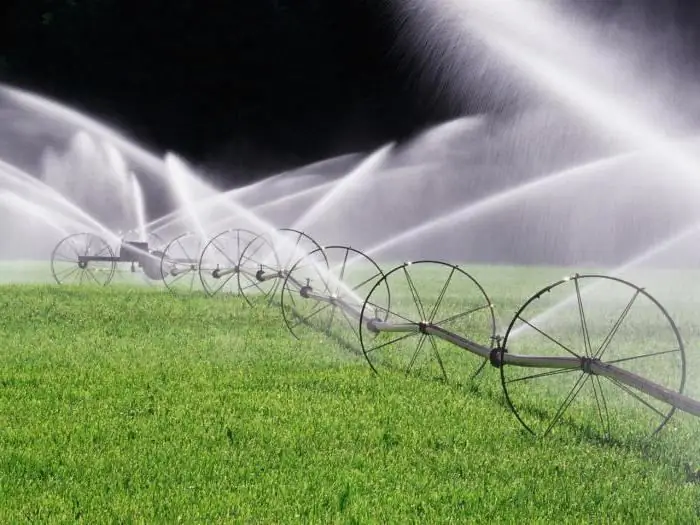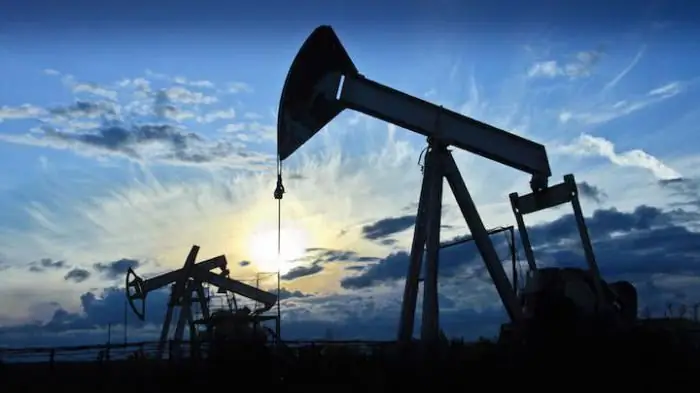2026 Author: Howard Calhoun | [email protected]. Last modified: 2025-01-24 13:10:39
Irrigation of the fields is one of the most important conditions for fertility. Providing plants with liquid affects the chemical processes taking place in them, the air and temperature conditions, the functioning of the soil at the microbiological level.

The event that solves the issues of delivery and uniform distribution of liquid on farmland exposed to natural drought is called agricultural irrigation. This definition allows us to understand the meaning and purpose of the described process in agricultural science.
Irrigation methods for agricultural land
To deliver liquid to agricultural land, methods are used:
- sprinkling;
- surface irrigation;
- drip irrigation;
- subsurface irrigation.
Sprinkling
Sprinkler irrigation is a method of irrigating lands with plants that have a shallow root system, provided by an automated method of distributing liquid. It is donemethod of artificial rain with established volumes of water. This method usually uses fertilizers that can dissolve in water, as well as pesticides (substances suitable for killing pests). Irrigation is classified, in turn, into:

- pulse irrigation is the watering of land in small volumes,
- gentle irrigation;
- ensuring the moisture regime of the near-soil atmospheric layer.
This method is mainly used in areas with an unstable humid climate, in the presence of difficulties in the relief, as well as in high standing groundwater.
Drip irrigation
The next method is drip irrigation. This is watering, which gives the liquid the opportunity to penetrate deep enough into the soil, and fertilizers to the root system of plants. Provides a set watering frequency. The positive side of the described process is the nutrition of the rhizosphere. The consumption of fluid, energy and fertilizer is about two to five times less than a conventional irrigation process. In this case, the supply of water to any crop is carried out in an environmentally friendly and harmless way. It is used in the presence of complex terrain, where insufficient water balance is determined, where extremely high water permeability takes place.

This method is popular in the production of irrigation process for vineyards, berry crops, vegetable crops and orchards with fruit trees.
Intrasoilirrigation
Soil irrigation is a way of flooding the root system of plants. Water supply of plants is carried out by special subsoil humidifiers, this creates favorable conditions for the constant supply of liquid to the roots, or nutrients necessary for plants. The advantage of this technique are:
- this is a fully mechanized way;
- creation and subsequent maintenance of soil looseness;
- efficient water supply;
- supplying the root system with all the nutrients required for normal growth.
Such irrigation is used in the area where the soil has a high capillary conductivity, there is no close standing of mineral groundwater. Thus, subsoil irrigation of fields is a great way out for farmland, but requires certain investments.
Surface irrigation
Surface irrigation of land is a process in which liquid is concentrated above the surface of the earth. This irrigation method is classified into the following subspecies:
- with large volume of water (flooding);
- through grooves;
- using a special bubbler attachment;
- using a small amount of water (or micro irrigation). This watering is the most economical of all.

When planning an irrigation system, it should be foreseen that infrequent and small irrigation volumes of water are ineffective, do not provide sufficient soil moisture. The lack of liquid in the soil creates an imbalance in the molecular tension of the water, leading to insufficient hydrobalance, and this, in turn, will lead to the death of the flora. The best wetting can be achieved in the case of a competent approach to planning the irrigation system. To achieve the correct water supply regime, it is necessary to take into account the structure of the soil, its permeable index, chemical composition, thermal index and aeration.
Irrigation of farmland: mode
To create favorable soil moisture during the growing season, that is, at the end of hibernation, a special irrigation regime is determined, that is, a combination of indicators: quantity, timing and volume of liquid. It should create in the soil the hydrobalance necessary for the corresponding culture in specific climatic conditions and economic purposes. This process requires strict compliance with the requirements of agrotechnical measures.

The irrigation regime of any crop under certain agro-climatic conditions must comply with the following requirements:
- The water demand of plants in a certain period of their development, and in relation to fruit crops, also obtaining high yields with certain agricultural practices with the addition of fertilizers at certain periods.
- Implementation of precise regulation of water, nutrient, s alt and temperature regimes of the soil.
- Increasing soil fertility, inadmissibility of erosion, excessive flooding, that is, waterlogging and salinization of land.
- The correct organization of labor, which creates an increase in itsproductivity through the use of modern automated methods.
- Accounting for changes in climatic, economic and agrotechnical conditions to eliminate significant fluctuations over the years and individual seasons in them.
Consequently, to determine the irrigation regime for a particular crop, it is necessary to know the total amount of irrigation water that plants need during the growing season under the proposed (or used) agricultural technology and natural conditions. This volume of water can be determined from the analysis of climatic, soil and some other conditions.
Irrigation impact on subsoil processes
The transition from non-irrigated to irrigated cropping creates a profound impact on soil formation in the form of transformations in soil physical condition, its s alt composition, temperature characteristics and aeration, chemical and bacterial intrasoil processes, and the rate of accumulation and decay of soil organic matter.

Irrigation of the soil is a mechanism that has a positive effect on the physical composition of the soil, leads to a decrease in its resistance to plowing, and ensures its physical ripeness. In the process of processing, such soil lends itself more quickly to the process of crumbling and loosening.
Irrigation water brings a certain amount of silt particles in a disturbed state, which settle on the surface of the fields as fertile deposits. After a sufficiently long period, this irrigation layer reaches a solid level. Thus, a newsoil.
Irrigation provides better conditions for subsoil microorganisms. Under the conditions of the necessary moisture regime of the soil, microbiological processes (nitrification) are activated. Irrigation has a huge impact on nodule bacteria, which are not formed in arid areas on the surface of legume roots.
Recommended:
What does a “tube” stream mean, and how does it affect the channel

Has it ever happened to you that when you came to visit a friend, you would not want to leave him? Surely many have such acquaintances with whom you can communicate without stopping and share the most frank. Such an action sometimes occurs on live broadcasts, where one person acts as a friend - a streamer
The meaning of the word "irrigation". What is irrigation?

Russian speech is replete with terms that came from foreign languages. One of them is the word "irrigation". What is irrigation? From Latin, this term is translated as "irrigation". It is used with different meanings in different areas of life
The land tax does not come - what to do? How to find out land tax

Describes what taxpayers should do if the land tax does not come. The main reasons for the lack of notification are given, as well as the rules for determining the amount of the fee
Why does the ruble depend on oil and not on gas or gold? Why does the ruble exchange rate depend on the price of oil, but the dollar exchange rate does not?

Many in our country are wondering why the ruble depends on oil. Why is it that if the price of black gold decreases, the price of imported goods rises, is it more difficult to get out to rest abroad? At the same time, the national currency becomes less valuable, and with it, all savings
Do pensioners pay land tax? Land tax benefits for pensioners

Do pensioners pay land tax? This topic is of interest to many. After all, older people are eternal beneficiaries. And so often relatives draw up real estate on them. What for? To avoid paying taxes. What can be said about the payment for land? Are pensioners en titled to any bonuses from the state in this area? What should the public know about the payment under study?

